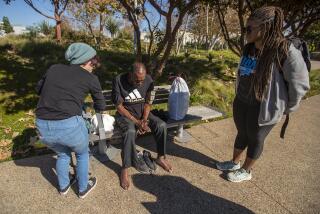Homeless: Story’s Portrayal of the Problems
- Share via
Nancy Hill-Holtzman’s article “Santa Monica Tangles With Homeless Issue” (Metro, March 29) would get an F in any journalism class in America for its utter abandonment of the principle of balance. She never bothers to quote any of the many people living in their cars and in the streets who really are “tangling” with the issues and who have some very good ideas about what is needed to alter their circumstances.
On the contrary, beginning with the headline (perhaps her editor’s), an entity called “Santa Monica” is represented as a human subject confronted with a nameless, faceless “homeless issue,” an object that is somehow not Santa Monica and presumably cannot think and speak for itself. The subheadline makes matters worse by calling people without houses “transients,” though many homeless Santa Monicans have been residents far longer than those who see them (and treat them) like subhuman aliens.
The article goes on to enact a textbook example of how to create a mysterious, scary group of “others,” who can be blamed for problems in our social system. Examples of how the article mystifies and marginalizes a population of men, women and children, many of them lifelong Santa Monica residents, most of them U.S. citizens, all of them refugees of the brutal economic changes occurring worldwide, include:
* The large photograph above the article pictures a person whose face is obscured and whose name is not given. Was this individual asked his permission to have his image used to de-personalize people without houses?
* The article persists in equating “residents” with housed people and “transients” with people without houses.
* It follows City Council Member Robert Holbrook, whose discourse separates people without houses from “the public” whose interests must be protected.
* It inaccurately reports that a “female transient” (a homeless woman?) “has been defecating” on a school lawn. At Tuesday night’s City Council meeting it was reported that this happened only once. More importantly, Hill-Holtzman chooses not to include the information that there are very few public lavatories in Santa Monica, even fewer of which remain open 24 hours a day.
If she were to talk to the nameless, faceless, scary “vagrants” her prose constructs, she would find children; among them a group who staged an acclaimed performance at Highways last fall; she would also find elderly women; one of whom is a 55-year resident of Santa Monica who was forced out of her board and care facility by developers; she would find disabled Vietnam veterans.
I, who am also a Santa Monica resident, also a member of “the public,” feel much safer among the people without houses I have met than I do when I read Hill-Holtzman’s prose with its casual disenfranchisement, objectification, and mystification of an aggregate of creative, intelligent, sensitive human beings.
I am not mollified by her having given me a voice in her March 31 report (“Council to Open Shelter for Homeless,” Westside Section) on the City Council meeting. Of the 27 people who wanted to speak that evening, and of the half-dozen or so who were finally allowed to speak at 1 a.m., many were homeless, as she accurately reports, but only I, who announced I was a professor so that I would be listened to, got quoted. The room was full that evening of people more knowledgeable than I about “homeless issues.” I urge Hill-Holtzman and other journalists to return to the principles of balanced journalism and start reporting what these well-informed supporters of our democratic political process have to say.
MARGUERITE WALLER
Santa Monica
More to Read
Sign up for Essential California
The most important California stories and recommendations in your inbox every morning.
You may occasionally receive promotional content from the Los Angeles Times.






